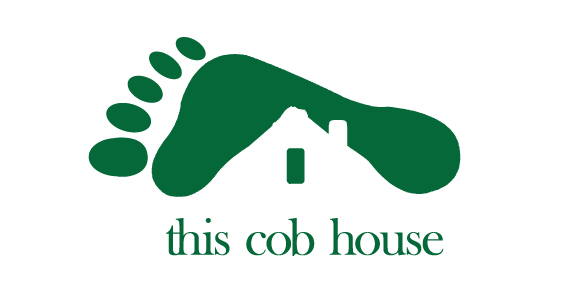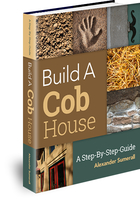Soil has proven to be a very suitable and successful building material throughout the world’s many climates. Consider that nearly half the world’s population lives in earthen dwellings. Whether the climate is harsh and arid or temperate with seasonal changes, a cob house is a winner because of their thermal mass and heat-cool retention.
Have you ever been in your garden on a hot day and started digging down into the soil and felt the coolness beneath the ground? The temperature beneath the ground is drastically cooler on a hot summer day than above ground where you’re standing. Also, when it’s cold outside you will discover warmth beneath the ground. This is why many animals live underground. They can survive the heat and winter freezes by burrowing and living underground.
An earthen home can provide very similar benefits to humans as underground burrows can do for animals. Let’s discuss how an earthen building can regulate the indoor temperature and keep us comfortable inside during the seasons.
Insulation
One of the few downsides to all earthen building materials is that they are poor insulators.
The two main ingredients in cob, soil and sand, have little conductive heat loss resistance (low R-value). The other highly insulative ingredient, straw, is included in such small amounts that it doesn’t increase the R-value of the cob in its regular amounts. Straw-heavy mixes can be created for high insulation value, but they do not have the load bearing capacity with the amount of fiber needed to get an adequate R-value.
According to the Cob Code Appendix U on Cob Construction, the unit R-value for cob walls is R-0.22 per inch of cob thickness. This comes out to about R-2.64 per foot thick of cob wall. Meaning, your cob walls would have to be several feet thick to compare to a strawbale wall which can be R-35 for the thickness of one bale.
What earthen materials lack in insulation properties they make up for with thermal mass.
Thermal Mass
Earthen building materials are very poor conductors of heat and have very low thermal conductivity. This means that heat from outside the building has a much harder and longer time to transfer through your walls and inside your home. Earthen materials will absorb heat, retain it, and then dissipate it back out slowly. Most modern, conventional building materials have the opposite attributes. However, materials such as concrete and fired brick have some thermal properties like earth, but they absorb and release heat quicker than earth materials do.
Cob homes have an amazing ability to regulate the indoor air temperature. Compare the indoor temperature fluctuations between a cob home and a concrete or cinder block home and you may be astonished at the results. Cob is a suitable building material for hot or cold climates due to its ability to keep indoor temperatures stable. Depending on your climate and comfort levels, this can eliminate the need for centralized heating systems and air conditioning. That’s some great energy saving potential right there!
“A mud house with walls 2 ft (0.6 m) thick, a well-insulated roof, and minimum-heat-gain doors and windows would have an indoor temperature range varying no more than about 6° – 8° F (3.3° – 4.4° C) year-round in most of the USA without central heating and air conditioning!”
– Glorious Mud, Gus W. Van Beek
Cob’s high thermal mass makes it possible for your walls to actually absorb sunlight heat, retain it throughout the day, and then release that heat to the inside of the home as outdoor temperatures lower. Thermal mass plays a big part in setting up a passive solar design.
Thermal mass which is a heat battery in the winter months acts as a cold storage in the Summer months. Thick mass walls like cob help to buffer the inside temperature. Hot air from the outside will slowly move through the walls during the day, but it will reverse its direction back to the outside as night comes on. The cool outdoor temperature of the night will force the hot air to vent out.
Many people wonder if they can build a cob home where the winters are cold and frigid. I would not truthfully say that cob is your best option for a cold climate if you’re worried about your home getting too cold, but I would also not tell you to rule cob out as a viable option either. If you’re building with cob in a cold climate, the building’s indoor temperature performance will depend on proper solar siting and passive solar design. We will also discuss further on in the book how to insulate cob walls so you can build even in very cold climates.
So in conclusion, earthen building materials have some amazing temperature regulating properties. They have poor insulation value but in many cases they make up for it with thermal mass.
Passive Solar Design
Passive solar design is a concept that is beneficial to understand for building an earthen home. It’s about designing a building so that it can effectively use the sunlight energy to create warmth inside the structure in the colder seasons and also not overheat in the hotter seasons. To benefit from the sun’s radiation for heating, we have to site and orient our homes so that sunlight enters.
Now that we understand the basics of thermal mass we can understand that thermal mass is what allows the walls to absorb the sun’s radiant heat throughout the day and then transmit it back out into the interior space to regulate the indoor temperature. As the temperatures drop low at night time, the temperature inside the building will self-regulate by the heat storage being released from the thermal mass of the cob to the inside the building.
Passive solar design basics are easy to learn, and these basic principles and concepts can bring you large benefits. By the end of this lesson, you should have a good understanding of passive solar and how to apply it to your building design.
There’s only one working part in this mechanism for passive solar energy. That is the Sun’s rotation. Passive solar design is something to work into your overall design with thoughtful consideration, but once your building is up you just leave the rest of the work to the Sun.
Facing South
Just by simply orienting the long side of a home to the south (in the Northern Hemisphere), without thought to any other solar design points, can cut your energy bills for heating by 30 percent in some cases. You can further increase your energy savings with proper window placements and thermal mass walls. This is why passive solar design is important to apply with an earth wall building.
Going back to site selection for a moment here, you want to choose a south-facing site for your building. A south, southeast, east, or southwest downward slope will also open up more “solar window” for sunlight exposure to your structure.
The point is to make sure that your site has an unobstructed sky view mainly to the south. Choose a site with unobstructed sunlight exposure from about 10 A.M. to 3 P.M. for as many days of the year as possible. More sunlight will increase your passive solar potential. It’s most important that there are not obstructions that will block the sun in the cold months of the year when you need the heat.
For the most optimal solar gain, orient the long axis of your home as perpendicular as possible to the South. The southern direction should be where the longest wall of your building is placed and aligned to.
From this direction, extend your arms straight out, at right angles to each other. Your hands will point southeast and southwest. Within your arms, you want about 80 percent of the sky to be visible and unobstructed above the arc of the winter sun’s path and below the line of the summer sun’s path, which is about 45 degrees above the winter arc.
This might all sound complicated, and if it does just stick to the basic premise that your south facing wall should point relatively southward (it does not need to be exactly to True South) and that you want to have an open view for the sunlight to shine on your south facing wall as much as possible in the winter months.
Window Placement
The orientation of the building and the placement of windows are important design elements that should be taken into consideration when using passive solar. The intelligent placement of windows is important so that you can get the right amount of sunlight to penetrate inside the building. The sunlight that you want to capture will mainly come from the south, southeast, and sometimes from the east. If you’re in the Southern Hemisphere, you would put the windows on the north side instead.
With passive solar design you want to situate your main living spaces of the building between solar south and southwest, with larger and predominant windows placed between the southeast and southwest walls.
Also keep in mind that the sun rises and sets in different locations as the sun moves throughout the year. During the winter, the sun rises in the southeast and sets in the southwest. In the summer, the sun will rise more to the northeast and set to the northwest.
Here are a few points for placing windows:
- Don’t place your windows too high. This prevents overheating in the summer, when the sun is high in the sky, and it ensures that low winter sunlight enters the building.
- Don’t place many windows in the north wall as this will provide a point for heat to escape from inside your building. You don’t get the same passive solar benefits on the north wall since the sun is not shining from that direction.
- Some windows can be placed in the east wall to allow morning sunlight in.
- Only add small windows in the west wall and don’t add too many. Big windows in the west facing walls can create overheating in the summer time as the sun goes down.
- Be more stingy with adding windows unless your climate is mild. Any glass that’s not adding to solar heating is constantly letting heat escape when you want to keep the inside warm. Glass is also constantly adding heat to your building when it’s very hot outside.
- At the winter solstice, when the sun is at its lowest point in the year, sunlight can penetrate more than twenty feet inside of a building. Keep this in mind when designing. You may opt for a more open floor plan because of this.
- Skylights are nice, but not very intelligent for passive solar design. They let in a lot of sunlight during the summers and also let precious heat escape during the winters.
More things to consider with passive solar design:
- Build roof overhangs to prevent excess sunlight penetration during the hotter months of the year. Since the sun is higher in the sky, the overhangs will block most of the sun rays from entering inside.
- It makes sense to design the inside of your house according to the sun’s orientation throughout the day. You can place your bedroom and/or breakfast area on the east/southeast side to capture the morning sunlight. You can place your workspace or living space to the south to capture the most daylight sun exposure, and then, for example, you can put a small nook on the west side to relax in during the evenings. Be aware that sunlight creates a bad glare on computer screens though. It might be good to have a sun-free room for things like this.
Ventilation and Ceiling Insulation
You need to have adequate ventilation and insulation to keep your building cool during the hotter times of the year. The cooling effect should be kept in mind when designing insulation and ventilation systems. They should both work together to reinforce the other.
The basic rule of thumb is to keep air flow circulating through your building. Ventilate roofs and attics so that air doesn’t become trapped in them. You can install soffit vents or cupulas to let hot air flow up and out of your building. Allowing hot, humid air to flow freely out the peaks of your building will prevent overheating on the inside, and will also prevent most mold and mildew issues.
As a general rule, don’t use a black rooftop. It absorbs a lot of heat and can make the surface of your roof reach over 150 degrees Fahrenheit on a bright summer day in most of the United States. In contrast, a white or other light colored roof can reflect up to 70 percent of the sun’s heat onto your roof. You can also insulate your ceilings for summer cooling. This prevents heat from coming in through the roof.
Decrease Summer Solar Gain
By understanding the principles of passive solar design, we know that the sun is high in the sky in the Summer so roof overhangs should be long enough to keep the sun from penetrating into the building.
Limit the number of windows on the east and west sides of your structure. They let in a lot of sunlight that can overheat your building. Be mindful of putting large windows or sliding glass doors on these sides. You can install shutters or curtains on these windows if you need to though.
Another option is to build patios on the east and west sides and cover them with arbors. The vegetation on the arbors will then shade these sides of your building from the sun.
Hybrid Buildings
Cob is a very versatile and adaptive building material. It has a long list of advantages for home building. Cob does not have to be a standalone building material though. It integrates very well with other materials and systems. If you want to use cob to its greater advantages and replace cob where it falls short, you can build a hybrid building system.
A Disadvantage of Cob
Probably the most noted disadvantage of cob and earthen building materials is their lack of insulation value. The insulation value for earthen building materials is around R3 per 12 inches of wall thickness. This is very low and insignificant. Compare the R-value of cob to that of a strawbale wall, which comes in somewhere at around R35 for the thickness of one bale. That’s a huge difference!
Insulation value is not always the be-all-end-all to a comfortable living space though. It depends on your location and climate. If you experience cold winters then you can consider a hybrid building design.
High Insulation Alternatives
There are a lot of highly insulative building materials that you can choose from if you decide to build a hybrid cob home. In this lesson, we’ll look at a few non-toxic building materials that you can use for insulating walls.
Strawbale
Strawbale has been a commonly used natural building material to complement a cob structure. Strawbale walls are thick and highly insulating. You get the highest R value for natural materials with strawbale, and the thermal retention properties of cob all in one building.
Straw-Clay
Straw-clay, also referred to as light-straw-clay, is a mixture of straw and mud slip that is packed into forms to create infill for walls. A 12 inch thick straw-clay wall has an R-value of about 26.
Hempcrete
Hempcrete is a combination of hemp cores and lime binder that is both lightweight and insulating. It has a cement-like consistency but hempcrete weighs about a seventh of the weight of concrete.
Hempcrete is not a structural building material, as with straw-clay, and is used as infill between framing. It is either compacted into forms or built in brick form. A 12 inch thick hempcrete wall has an R-value of about 25.
Hybrid Building Design
A hybrid building design is actually quite simple after you understand passive solar design principles. The purpose of creating a hybrid design is to keep the inside of the building warmer during the cold seasons.
We know that we get the most sunlight exposure from the south and the east. For this reason, it’s best to keep both the south and the east walls as cob. This way, they are able to absorb maximum sunlight into their thermal mass to heat the inside of the building.
The north side is the coldest side and does not receive any direct sunlight exposure. This is the primary wall that you would want to change the building material on. Put a high insulation material on the northern side of the building. This will prevent colder air from coming in and your indoor heat from escaping.
It’s also common in hybrid design to replace the west wall with a high insulating material as well. This side of the building received little sunlight in the Winter months and can be a cold spot. The most important side to keep as cob is the southern side though. This is where you can take full advantage of cob’s thermal mass properties. You might lose some heat because of cob’s poor insulation value, but you gain back more heat through the thermal mass advantages if you’ve designed according to passive solar design.



